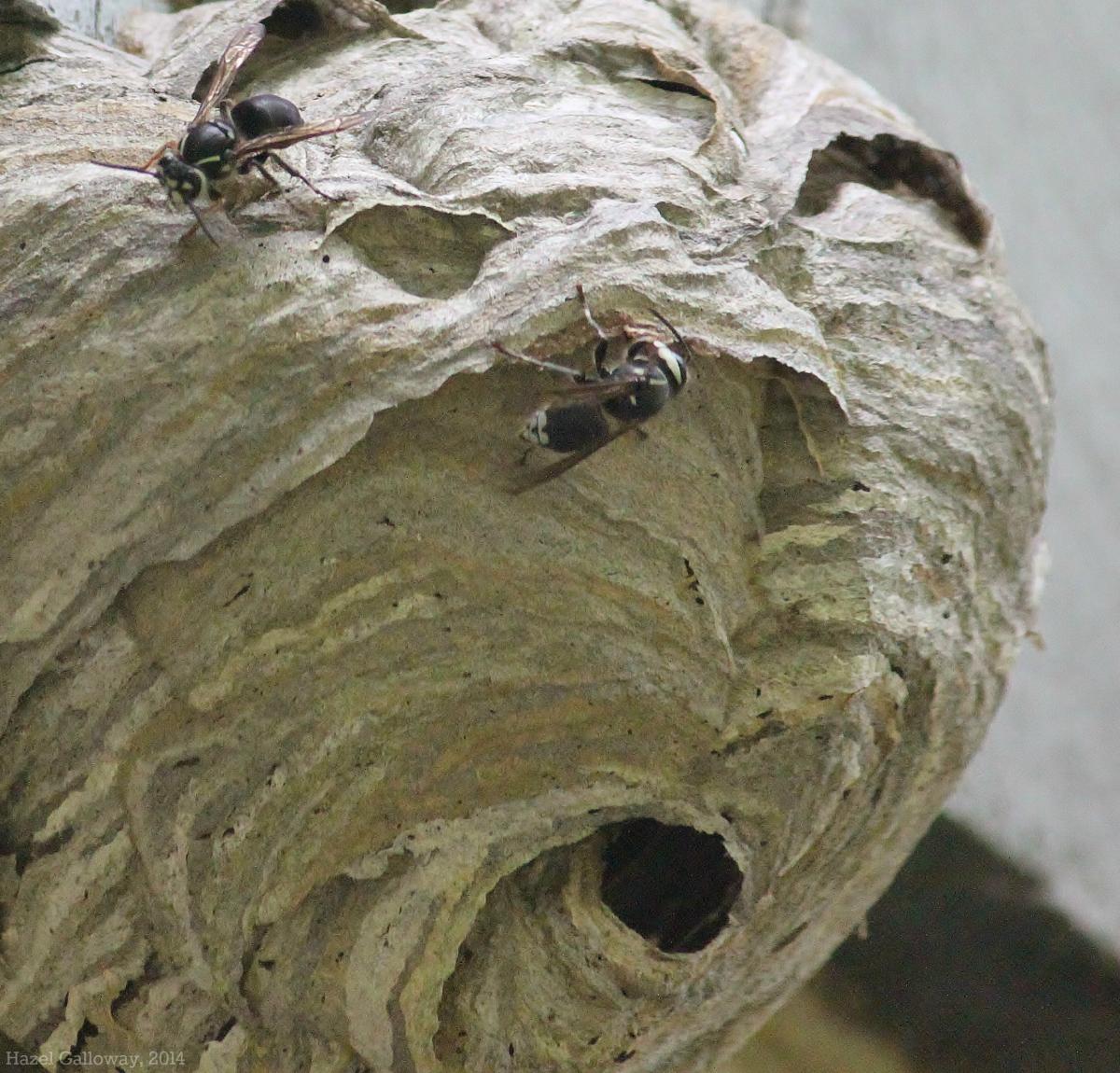The completely interdependent communities formed by social wasps, such as the baldfaced hornet, are often described as superorganisms. The idea of a superorganism was defined in the early 1930s by the social insect researcher Alfred Emerson, who wrote that “the whole colony behaves as a single animal, the state is selected, not the single individuals; and the various forms behave exactly like the parts of one individual in the course of ordinary selection.” A paper published in 2009 restates that idea in somewhat different terms by defining group adaptionism as “the idea that groups of organisms can be viewed as adaptive units in their own right” (Gardner and Graffen). According that paper, such systems only occur where the group is either composed of genetically identical individuals, of where competition within the group is repressed. In the case of the baldfaced hornet and many other social insects, the former is true.
 Queens—fertile females—are the only members of this species that survive the winter. In the spring, a queen will emerge from a hiding place in a hollow tree, under rocks or bark, or inside walls and set about building a nest. Alone, she gathers cellulose from weathered or rotting wood and mixes it into a paste with her own saliva. She uses the mixture, which dries into a paper-like substance, to shape the outside of a small nest and build several brood cells on the inside. Into these, she lays eggs that will hatch into sterile females genetically identical to her herself (workers). After they hatch, she feeds and tends the larvae until they become adults, at which point they assume all the responsibilities of building and protecting the nest, gathering food, and tending to the larvae. The queen does not leave the nest for the rest of her life.
Queens—fertile females—are the only members of this species that survive the winter. In the spring, a queen will emerge from a hiding place in a hollow tree, under rocks or bark, or inside walls and set about building a nest. Alone, she gathers cellulose from weathered or rotting wood and mixes it into a paste with her own saliva. She uses the mixture, which dries into a paper-like substance, to shape the outside of a small nest and build several brood cells on the inside. Into these, she lays eggs that will hatch into sterile females genetically identical to her herself (workers). After they hatch, she feeds and tends the larvae until they become adults, at which point they assume all the responsibilities of building and protecting the nest, gathering food, and tending to the larvae. The queen does not leave the nest for the rest of her life.
All summer, the queen continues to lay worker eggs, which other workers feed with premasticated insects (particularly other yellow jackets) they hunt, kill, and carry back to the nest. Large nests can sometimes contain 400 individuals. As fall approaches, workers construct a new set of larger brood cells intended for young queens. Larvae raised in those cells receive more food than their sisters raised in smaller cells. However, the only differences between queens and workers is in gene expression—if worker larvae are moved to larger brood cells at an early enough age and receive the extra ministrations intended for young queens, they, too will develop into fertile queens. At the same time, the queen begins to lay eggs that will develop into males. When they are mature, the young queens and the males leave the nest and mate. Around the same time, the old queen dies, beginning a breakdown of the social order in the nest. By the first frost, all members of the hive will have died except for the new queens.
Despite its name, this is not a true hornet but rather a yellow jacket, misleadingly labelled because of its large size. As well as being the largest of the native yellow jackets, its distinctive white-and-black body sets it apart from the yellow-and-black patterns common in most other species. Queens, typically the largest individual in the colony, can reach 20 mm in length. They have a different abdominal pattern than workers, with white markings present on the upperside of their third abdominal segment, as well as the fourth, fifth, and sixth as workers display. Males have seven abdominal segments, and also display white markings on the final four.
These insects build nests in trees and bushes that can reach 60 cm in height and 45 in width. These nests can be found anywhere from one meter off the ground to 18 meters in the air. D. maculata is mainly diurnal, and workers tend to retreat to the nest at nightfall. This individual is a sterile female worker captured from a nest on the station.
Hazel Galloway
Sources:
- Gardner, A, and A Grafen. "Capturing the superorganism: a formal theory of group adaptation." Journal of Evolutionary Biology 22.4 (2009): 659-671.
- http://ento.psu.edu/extension/factsheets/baldfaced-hornet
- http://entnemdept.ifas.ufl.edu/creatures/urban/occas/hornet_yellowjacket.htm
- http://www.news.gatech.edu/2008/02/18/research-uncovers-social-dynamics-yellow-jackets



